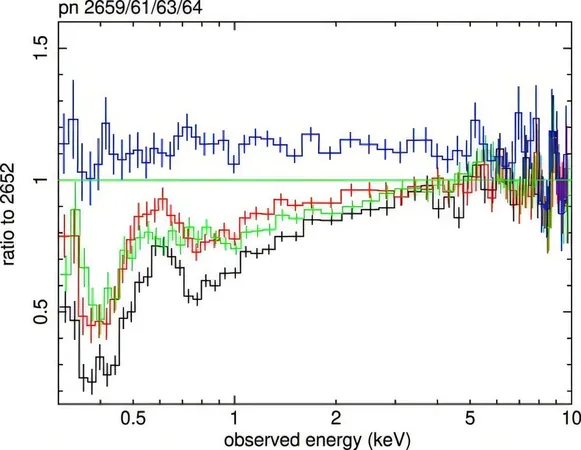
Galactic Glutton: Distant Supermassive Black Hole Caught in a Feeding Frenzy!
2025-06-17
Author: Yu
A Cosmic Revelation Unveiled
A groundbreaking study from the University of Leicester has unveiled a shocking phenomenon: a distant supermassive black hole (SMBH) has been caught 'overeating'—and its gluttony is literally blowing excess matter out into space at astonishing speeds!
Matter Ejection at Mind-Blowing Speeds
Published in the esteemed Monthly Notices of the Royal Astronomical Society, this research marks a first in our understanding of how excessive consumption by the black hole leads to explosive ejections. The black hole in question, residing in the Seyfert galaxy PG1211+143, is hurling matter away at nearly one-third the speed of light—a staggering 0.27c!
The Dance of Cosmic Forces
Since its discovery in 2001, powerful outflows of ionized gas have intrigued astronomers, particularly through the observations made by ESA's XMM-Newton X-ray Observatory. These outflows are now understood as a hallmark of luminous active galactic nuclei (AGN), showcasing the chaotic yet mesmerizing dance between matter and gravity.
What Makes a Black Hole?
To grasp the significance of this discovery, it's crucial to understand black holes. Formed from the remnants of massive stars collapsed into a point of infinite density, they possess gravitational forces so intense that not even light can escape. Supermassive black holes, often found at the heart of galaxies, are vastly more powerful than their stellar counterparts.
Tracking a Celestial Beast
In a five-week observational study in 2014, Leicester scientists peered into PG1211+143—a galaxy located a staggering 1.2 billion light years away. Their findings revealed unexpected inflows adding mass equivalent to at least ten Earths around the black hole. This mass accumulation was later confirmed through gravitational redshift observations.
From Accretion to Ejection
What’s even more fascinating is the mechanics behind this process. As matter spirals into the black hole, it heats up to several million degrees due to gravitational forces, generating intense radiation pressure that flings excess material into the cosmos.
A Call to Observe and Understand
Prof. Ken Pounds, the lead author of the research, expressed excitement about the findings. "Establishing the direct link between the massive inflow of matter and the resulting outflow provides a unique opportunity. We can now observe how a supermassive black hole grows by monitoring these hot, relativistic winds!"
The Future of Cosmic Exploration
With the continued support of the Neil Gehrels Swift Observatory, which provides critical simultaneous ultraviolet data, astronomers are better equipped than ever to decode the enigma of black hole accretion. As we venture deeper into the cosmos, the quest to unravel these celestial giants promises to reveal even more extraordinary secrets lurking in the universe!




 Brasil (PT)
Brasil (PT)
 Canada (EN)
Canada (EN)
 Chile (ES)
Chile (ES)
 Česko (CS)
Česko (CS)
 대한민국 (KO)
대한민국 (KO)
 España (ES)
España (ES)
 France (FR)
France (FR)
 Hong Kong (EN)
Hong Kong (EN)
 Italia (IT)
Italia (IT)
 日本 (JA)
日本 (JA)
 Magyarország (HU)
Magyarország (HU)
 Norge (NO)
Norge (NO)
 Polska (PL)
Polska (PL)
 Schweiz (DE)
Schweiz (DE)
 Singapore (EN)
Singapore (EN)
 Sverige (SV)
Sverige (SV)
 Suomi (FI)
Suomi (FI)
 Türkiye (TR)
Türkiye (TR)
 الإمارات العربية المتحدة (AR)
الإمارات العربية المتحدة (AR)